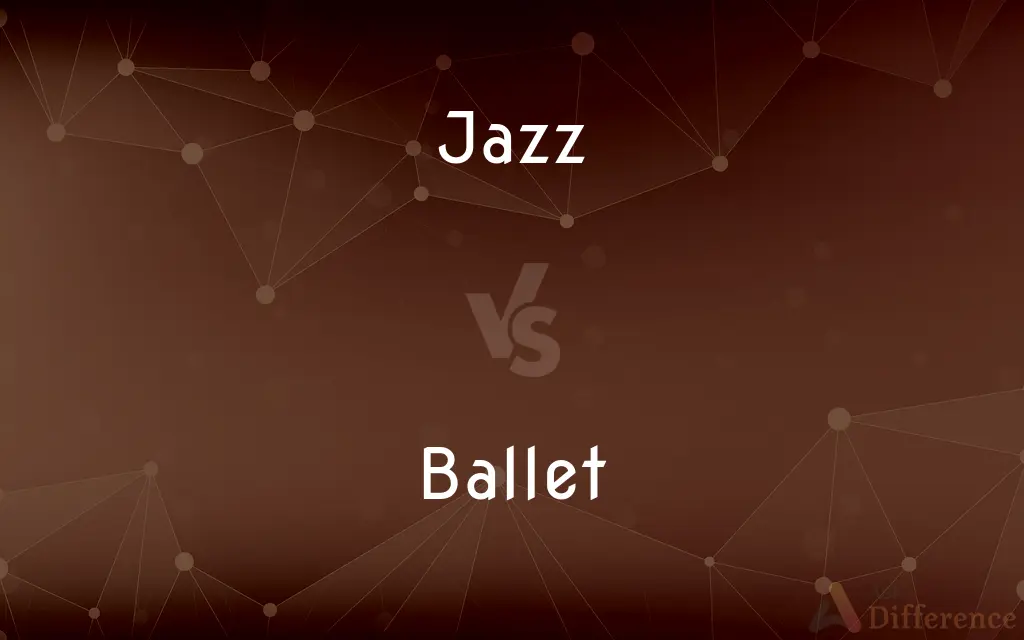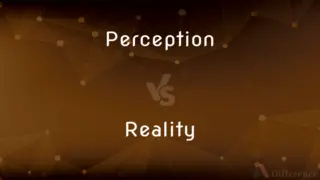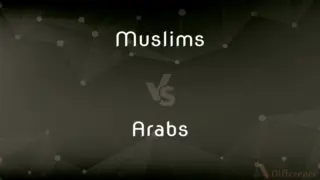Jazz vs. Ballet — What's the Difference?
By Fiza Rafique & Maham Liaqat — Updated on April 16, 2024
Jazz is a dynamic, improvisational dance form rooted in African American culture, while ballet is a classical, highly structured style with European origins.

Difference Between Jazz and Ballet
Table of Contents
ADVERTISEMENT
Key Differences
Jazz dance is characterized by its energetic and expressive nature, often incorporating elements of improvisation and personal interpretation. On the other hand, ballet emphasizes precise, formalized steps and movements, with a focus on technique and alignment.
Jazz often features syncopated rhythms, isolation movements, and a connection to jazz music, reflecting its origins in African American cultural expressions. Whereas ballet is performed to classical music and is known for its grace and fluidity, with movements that flow seamlessly from one to another.
The attire in jazz dance typically includes form-fitting, comfortable clothing that allows for a broad range of motion, suitable for high-energy routines. In contrast, ballet dancers wear specific costumes like leotards and tutus, which highlight the elegance and lines of the body.
Jazz dance classes usually encourage personal style and expression, allowing dancers to interpret music in their unique way. Ballet classes, however, are more focused on developing specific techniques and adhering to a traditional syllabus, leaving less room for individual interpretation.
In terms of performance, jazz dancers often engage directly with their audience, featuring dynamic facial expressions and gestures. Ballet performances, however, are generally more reserved, prioritizing a portrayal of narrative and character through movement rather than direct interaction.
ADVERTISEMENT
Comparison Chart
Origin
African American culture
European court dances
Music
Jazz music
Classical music
Key Characteristics
Improvisation, expressiveness
Precision, fluid movements
Attire
Comfortable, flexible
Leotards, tutus
Audience Interaction
Direct, engaging
Reserved, narrative-focused
Compare with Definitions
Jazz
A dance form known for its rhythmic and improvisational elements.
She performed a jazz routine full of energetic kicks and spins.
Ballet
Involves specific positions and movements, like the five basic positions of the feet.
In ballet class, we focused on the correct execution of the third position.
Jazz
Typically features costumes that allow for free movement.
For the jazz recital, she wore a sequined top and stretchy pants.
Ballet
Ballet is performed to classical music, enhancing the theatrical experience.
The ballet performance was set to a beautiful orchestral piece.
Jazz
Jazz dance blends styles such as tap, ballet, and modern dance.
Jazz classes often incorporate elements from other dance disciplines.
Ballet
Requires specific attire to accentuate the lines of the dancer's body.
He wore a fitted white leotard and tights for his ballet solo.
Jazz
It is often performed to jazz music, emphasizing strong beats and rhythms.
The band played a lively jazz tune, inspiring the dancers to improvise.
Ballet
A classical dance form characterized by grace and precision of movement.
She has been practicing ballet since she was four, perfecting her pirouettes and pliés.
Jazz
Jazz encourages personal expression and style.
Each dancer in the jazz ensemble brought a unique flair to the performance.
Ballet
Ballet often tells a story through dance and mime.
The ballet narrated the story of Cinderella through expressive dance and gestures.
Jazz
Jazz is a music genre that originated in the African-American communities of New Orleans, Louisiana, United States, in the late 19th and early 20th centuries, with its roots in blues and ragtime. Since the 1920s Jazz Age, it has been recognized as a major form of musical expression in traditional and popular music, linked by the common bonds of African-American and European-American musical parentage.
Ballet
Ballet (French: [balɛ]) is a type of performance dance that originated during the Italian Renaissance in the fifteenth century and later developed into a concert dance form in France and Russia. It has since become a widespread and highly technical form of dance with its own vocabulary.
Jazz
A style of music, native to America, characterized by a strong but flexible rhythmic understructure with solo and ensemble improvisations on basic tunes and chord patterns and, more recently, a highly sophisticated harmonic idiom.
Ballet
A classical dance form characterized by grace and precision of movement and by elaborate formal gestures, steps, and poses.
Jazz
Big band dance music.
Ballet
A theatrical presentation of group or solo dancing to a musical accompaniment, usually with costume and scenic effects, conveying a story or theme.
Jazz
Animation; enthusiasm.
Ballet
A musical composition written or used for this dance form.
Jazz
Nonsense.
Ballet
A classical form of dance.
A classically-trained ballet dancer
Jazz
Miscellaneous, unspecified things
Brought the food and all the jazz to go with it.
Ballet
A theatrical presentation of such dancing, usually with music, sometimes in the form of a story.
Let's go to the ballet in the theatre tomorrow!
Jazz
(Music) To play in a jazz style.
Ballet
The company of persons who perform this dance.
Zara joined the ballet at the age of 14.
Jazz
To utter exaggerations or lies to
Don't jazz me.
Ballet
(music) A light part song, frequently with a fa-la-la chorus, common among Elizabethan and Italian Renaissance composers.
Jazz
To give great pleasure to; excite
The surprise party jazzed the guest of honor.
Ballet
A (small) ball i.e. roundel on a coat of arms, called a bezant, plate, etc., according to colour.
Jazz
To cause to accelerate.
Ballet
(figurative) Any intricate series of operations involving coordination between individuals.
Jazz
To exaggerate or lie.
Ballet
To perform an action reminiscent of ballet dancing.
Jazz
(music genre) A musical art form rooted in West African cultural and musical expression and in the African American blues tradition, with diverse influences over time, commonly characterized by blue notes, syncopation, swing, call and response, polyrhythms and improvisation.
Ballet
An artistic dance performed as a theatrical entertainment, or an interlude, by a number of persons, usually women. Sometimes, a scene accompanied by pantomime and dancing.
Jazz
Energy, excitement, excitability.
Ballet
The company of persons who perform the ballet.
Jazz
The substance or makeup of a thing.
What jazz were you referring to earlier?
What is all this jazz lying around?
Ballet
A light part song, or madrigal, with a fa la burden or chorus, - most common with the Elizabethan madrigal composers; - also spelled ballett.
Jazz
Unspecified thing(s).
Ballet
A bearing in coats of arms, representing one or more balls, which are denominated bezants, plates, etc., according to color.
Jazz
(with positive terms) Something of excellent quality, the genuine article.
Ballet
A theatrical representation of a story performed to music by ballet dancers
Jazz
Nonsense.
Stop talking jazz.
Ballet
Music written for a ballet
Jazz
Semen, jizz.
Jazz
To destroy.
Jazz
To play (jazz music).
Jazz
To dance to the tunes of jazz music.
Jazz
To enliven, brighten up, make more colourful or exciting; excite
Jazz
To complicate.
Jazz
(intransitive) To move (around/about) in a lively or frivolous manner; to fool around.
Jazz
To distract or pester.
Jazz
To ejaculate.
Jazz
A type of music that originated in New Orleans around 1900 and developed through increasingly complex styles, but generally featuring intricate rhythms, improvisation, prominent solo segments, and great freedom in harmonic idiom played frequently in a polyphonic style, on various instruments including horn, saxophone, piano and percussion, but rarely stringed instruments.
Jazz
Empty or insincere or exaggerated talk; as, don't give me any of that jazz.
Jazz
A style of dance music popular in the 1920s; similar to New Orleans jazz but played by large bands.
Jazz
Empty rhetoric or insincere or exaggerated talk;
That's a lot of wind
Don't give me any of that jazz
Jazz
A genre of popular music that originated in New Orleans around 1900 and developed through increasingly complex styles
Jazz
A style of dance music popular in the 1920s; similar to New Orleans jazz but played by large bands
Jazz
Play something in the style of jazz
Common Curiosities
What type of music is ballet usually performed to?
Ballet is typically performed to classical music.
What is the primary focus of jazz dance?
Jazz dance focuses on rhythm, expression, and personal style.
What is a key characteristic of ballet?
Ballet is known for its precise technique and graceful movements.
How do jazz dancers typically interact with their audience?
Jazz dancers often engage directly with the audience through facial expressions and gestures.
How does jazz dance promote personal expression?
Jazz dance allows dancers to interpret and express music in their personal style, often improvising movements.
How do costumes impact the performance of jazz and ballet?
Costumes in jazz are designed for functionality and expressiveness, while ballet costumes enhance the narrative and elegance.
What role does improvisation play in jazz dance?
Improvisation is a core component of jazz, allowing dancers to explore and create spontaneous movements.
What attire do ballet dancers wear?
Ballet attire includes items like leotards, tutus, and ballet slippers to highlight the dancer's form and technique.
Do jazz and ballet require different types of music?
Yes, jazz is often performed to jazz and contemporary music, while ballet is set to classical music.
Can ballet include elements of improvisation?
Ballet is generally choreographed and does not include improvisation like jazz.
What is the importance of alignment in ballet?
Proper alignment is crucial in ballet to prevent injuries and maintain the aesthetics of the dance form.
What are typical jazz dance costumes?
Jazz dance costumes are usually flexible and comfortable, allowing for a wide range of movements.
What are the physical demands of ballet compared to jazz?
Ballet requires extreme flexibility and precision, while jazz demands high energy and adaptability.
How do the origins of jazz and ballet differ?
Jazz originated from African American culture, incorporating various dance forms, whereas ballet originated in the European courts.
Can someone train in both jazz and ballet?
Yes, many dancers train in both styles to enhance their versatility and technique.
Share Your Discovery

Previous Comparison
Perception vs. Reality
Next Comparison
Muslims vs. ArabsAuthor Spotlight
Written by
Fiza RafiqueFiza Rafique is a skilled content writer at AskDifference.com, where she meticulously refines and enhances written pieces. Drawing from her vast editorial expertise, Fiza ensures clarity, accuracy, and precision in every article. Passionate about language, she continually seeks to elevate the quality of content for readers worldwide.
Co-written by
Maham Liaqat














































